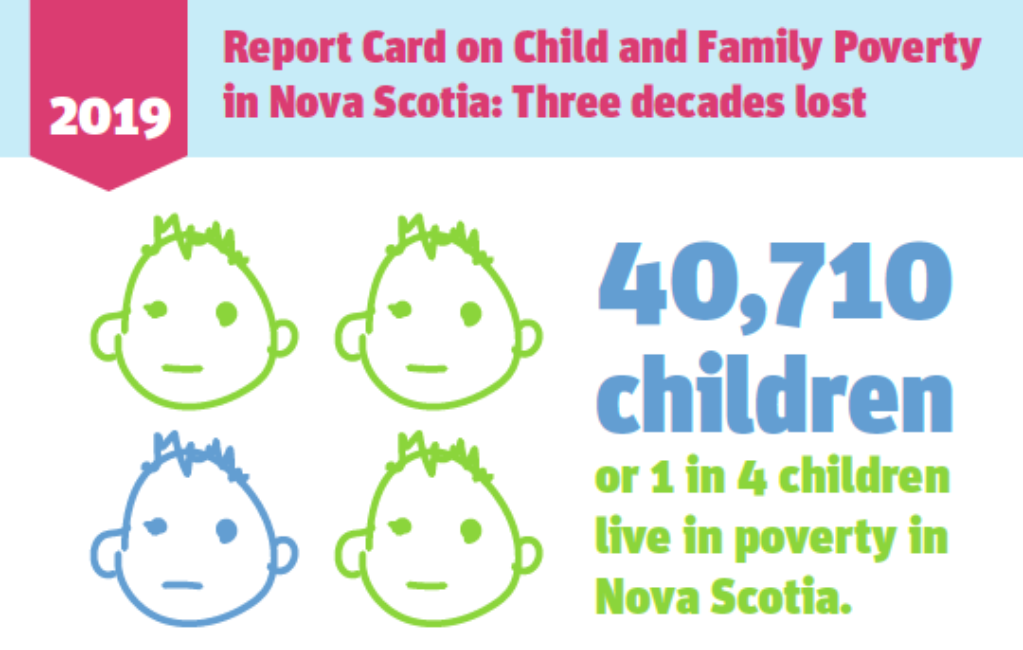It has been 30 years since the all-party resolution in the House of Commons to eliminate poverty among Canadian children by the year 2000. It is also almost 30 years since Canada ratified the UN Convention on the Rights of the Child in 1991. Article 27 of the Convention directs signatories to “recognize the right of every child to a standard of living adequate for the child’s physical, mental, spiritual, moral, and social development.”
As we enter the beginning of a new year and a new decade, we mourn for the generations of children whose parents want nothing more than to provide them with what they need to thrive.
As a society in the 10th wealthiest nation in the world, we have an obligation, moral and legal, to support these families, to uphold the rights of the child and to end poverty. Unfortunately, a significant number of children remain in poverty across Canada.
Summary of Key Findings
- 40,710: The number of children living in poverty in Nova Scotia, which amounts to 24.2% or close to 1 in 4 children.
- Less than 1%: the percentage decrease of children living in low-income circumstances in Nova Scotia since the 1989 promise to end child poverty.
- 3rd highest: By 2017, Nova Scotia has the third-highest provincial child poverty rate in Canada, and the highest rate in Atlantic Canada.
- 67,350: The number of children that would be living in poverty if not for government income benefits, which amounts to a 39.5% reduction in child poverty.
Canada now has a poverty reduction strategy, passed into legislation in June 2019 by the federal government, signaling a renewed commitment to reduce if not eradicate poverty in Canada. However, aspects of this legislation disappoint, including weak targets, long timelines, and the absence of reference to economic security as a human right.
While there has been an important trend downwards in the national rate of child poverty since 2015, the latest data for Canada continues to reveal stark differences depending on where the family lives in Canada, or within our province, and depending on their social group.
While the Nova Scotia government challenges the validity of the numbers, families continue to struggle under the weight of the daily stress to meet their daily needs.
Government benefits matter
The welcomed improvements made by the federal government with the introduction of the Canada Child Benefit in 2016 are not enough to maintain meaningful poverty reduction for children in Nova Scotia. Given the depth of poverty faced by so many families and complex reasons for poverty rooted in historical inequalities (that lead to low incomes), much more investment in families and children is necessary.
The Nova Scotia government boasts about the likelihood that 2020 will mark the fourth consecutive year that it has tabled budgets with surpluses. Doesn’t a surplus really mean underspending while thousands of children live in poverty?
Ending family and child poverty
Social investment in families and children is required to secure our province’s future. Poverty impedes the rights of parents to raise children in safe and healthy conditions. Poverty also harms children’s ability to grow up healthy and to develop their potential for full participation in society. Article 6 of the Convention on the Rights of the Child, which directs signatories to “ensure to the maximum extent possible the survival and development of the child” is the most important social contract government can make to uphold child rights and build healthy families and communities.
Poverty is not just a measure of inadequate income to meet need. It is realized in food, housing, and transportation insecurity, poor health outcomes, and the frequent despair of ends not meeting due to structurally imposed conditions beyond individual control – i.e. low wages, precarious employment, weak income supports, racial and gender discrimination, continual colonialization, social and geographical isolation, and lack of affordable and accessible early childcare.
The province’s poor record of poverty reduction since 1989, and more recent failure in mirroring the progress made in other jurisdictions in Canada, shows the urgent need for more robust public policy and investment.
It is long past the time for Nova Scotia to act on the evidence before us. We know that redistribution of income through the tax system has proven to be effective in lowering poverty rates.
Three decades have been lost.
No more children should be left behind.
Lesley Frank, PhD, is CCPA-NS Research Associate, and Associate Professor, Department of Sociology, Acadia University and Laura Fisher is a Master’s student in Sociology, Acadia University. They are the co-authors of the 2019 NS report card.
An edited version of this blog appeared in the Halifax Chronicle Herald.







